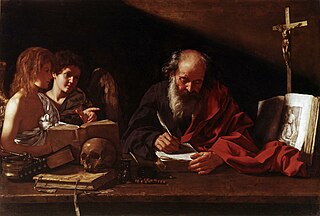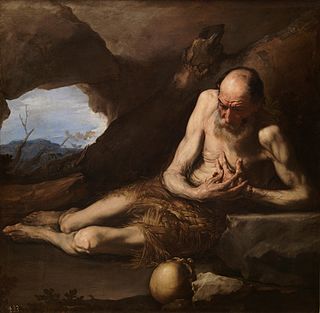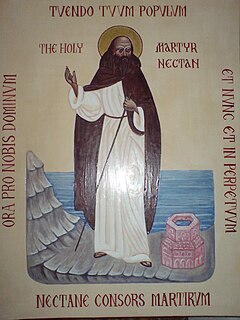
Anthony or Antony the Great, was a Christian monk from Egypt, revered since his death as a saint. He is distinguished from other saints named Anthony such as Anthony of Padua, by various epithets: Saint Anthony, Anthony of Egypt, Anthony the Abbot, Anthony of the Desert, Anthony the Anchorite, Anthony the Hermit, and Anthony of Thebes. For his importance among the Desert Fathers and to all later Christian monasticism, he is also known as the Father of All Monks. His feast day is celebrated on 17 January among the Orthodox and Catholic churches and on Tobi 22 in the Coptic calendar.
Pope Telesphorus was the bishop of Rome from c. 126 to his death c. 137, during the reigns of Roman Emperors Hadrian and Antoninus Pius. He was of Greek ancestry and born in Terranova da Sibari, Calabria, Italy.

St Benet's Abbey was a medieval monastery of the Order of Saint Benedict, also known as St Benet's at Holme or Hulme. It was situated on the River Bure within the Broads in Norfolk, England. St Benet is a medieval English version of the name of St Benedict of Nursia, hailed as the founder of western monasticism. At the period of the Dissolution of the Monasteries the abbey's possessions were in effect seized by the crown and assigned to the diocese of Norwich. Though the monastery was supposed to continue as a community, within a few years at least the monks had dispersed. Today there remain only ruins.

St Benet's Hall is a Permanent Private Hall (PPH) of the University of Oxford. Its principal building is located at the northern end of St Giles' on its western side, close to the junction with Woodstock Road, Oxford. Established in 1897 by Ampleforth Abbey, St Benet's Hall original historic function was to allow its monks to be able to study for secular degrees at the university. The hall historically has a Benedictine and Roman Catholic ethos. Today, St Benet's Hall hosts an international community consisting of 79 undergraduate students and 44 graduate students of all faiths and none. Unlike other Colleges, St Benet's Hall does not have a High Table, but one Common Table which is shared by all members of the Hall.

A hermit, or eremite, is a person who lives in seclusion. Eremitism plays a role in a variety of religions.
St Benet or St Benet's may refer to:

Godric of Finchale was an English hermit, merchant and popular medieval saint, although he was never formally canonised. He was born in Walpole in Norfolk and died in Finchale in County Durham.

Paul of Thebes, commonly known as Paul, the First Hermit or Paul the Anchorite, was an Egyptian saint regarded as the first Christian hermit, who was claimed to have lived alone in the desert of Egypt from the age of sixteen to the age of one hundred and thirteen years old. He is venerated as a saint by the Catholic Church as well as the Eastern Orthodox Church and Oriental Orthodox Churches.

Saint Nectan, sometimes styled Saint Nectan of Hartland, was a 5th-century holy man who lived in Stoke, Hartland, in the English county of Devon, where the prominent St Nectan's Church, Hartland is dedicated to him.

Saint Æthelwold of Farne was a late 7th-century hermit who lived on Inner Farne, off the coast of the English county of Northumberland.

Lanivet is a village and civil parish in Cornwall, England, United Kingdom. The village is situated approximately 2+1⁄2 miles (4.0 km) southwest of Bodmin, and before the Bodmin by-pass was built, the A30 road between London and Land's End passed through the village. The Saints' Way long-distance footpath passes Lanivet near its half-way point.
John Capon, aliasJohn Salcot was a Benedictine monk who became bishop of Bangor, then bishop of Salisbury under Henry VIII. He is often referred to as John Salcot alias Capon.

Rumburgh is a village and civil parish in the English county of Suffolk. It is 3.5 miles (5.6 km) north-east of the market town of Halesworth in the East Suffolk District. The population of the parish at the 2011 United Kingdom census was 327.
Locution is a paranormal phenomenon or supernatural revelation where a religious figure, statue or icon speaks, usually to a saint. Phenomena of locutions are described in the lives of Christian saints such as Saint Mary of Egypt, who heard the locution from the Icon of Virgin Mary at the Holy Sepulchre or in case of the Saint Henry of Coquet Island who experienced the locution from the figure of Christ crucified.

Barloc of Norbury was a medieval Catholic saint and hermit, from Anglo-Saxon England.

Eadwold of Cerne, also known as Eadwold of East Anglia, was a 9th-century hermit, East Anglian prince and patron saint of Cerne, Dorset, who lived as a hermit on a hill about four miles from Cerne. His feast day is 29 August.

Saint Huna of Thorney was a seventh century priest and hermit. His influence in the Northumbrian and Anglian courts make him an important figure in the Christianisation of Anglo-Saxon England.
Mybbard and Mancus were two Cornish saints of the 6th century.
Hugh was a French knight and Benedictine monk, abbot of monasteries in England and France.

St Benet's Hall Boat Club is a rowing club for members of St Benet's Hall, Oxford. It is based on the Isis at Boathouse Island, Christ Church Meadow, Oxford.












